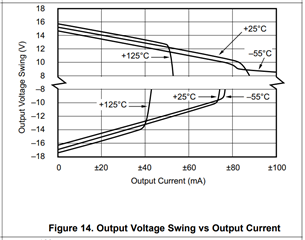Hi,
I'm looking at the datasheet for this part and wondering if there is a current-limiting feature that limits the short circuit output current to 80 mA, or is there potential for it to be greater than 80 mA?
Thank you
This thread has been locked.
If you have a related question, please click the "Ask a related question" button in the top right corner. The newly created question will be automatically linked to this question.
Hi,
I'm looking at the datasheet for this part and wondering if there is a current-limiting feature that limits the short circuit output current to 80 mA, or is there potential for it to be greater than 80 mA?
Thank you
Hi Andrew,
The short circuit current is a function of the output stage maximum current drive capability or a function of the output stage transistors. The device does not have a current limit function.
As you have mentioned, the DRV134 is specified as typical ±85mA at 25C, and the short circuit changes with temperature as shown on Figure 16. As shown on the plots below, the device can only drive around ±50mA typical at the higher temperatures. Keep in mind, this is the typical current the device can drive and there is no specified minimum.

The circuit designer has to also account for the limitations of output voltage swing vs output current. The short-circuit current and output current capability is a strong function of temperature. As the current load increases, the output swing to the rail is limited as shown on the plots above. Best practice is to design the device for circuits that will need to drive ±30mA or less, to ensure the device works within its linear range accounting for temperature and allowing margin for device variation.

Thank you and Regards,
Luis
My confusion lies with the wording in TI's "Understanding Operational Amplifiers" document. They define short circuit output current as "The maximum output current available from the amplifier with the output shorted to ground, to either supply, or to a specified point". Does this mean there is 85 mA max available to the load when a short occurs, or does it mean that 85 mA max will flow out through the short?
Hi Andrew,
Yes, the application note: Understanding Operational Amplifier Specifications, defines the short-circuit current as "The maximum output current available from the amplifier with the output shorted to ground, to either supply, or to a specified point." This document covers the general definition of short circuit current for different amplifiers for background information, and the device specific datasheet will define the actual load test conditions.
In the case of the DRV134/5, the short circuit current is measured with the output shorted to GND or loaded with a very small resistor referred to GND while powered with +/-18V bipolar supplies. This is the current that the output sources and sinks while the device attempts to drive a positive or negative voltage, but the output stage is limited by the current drive capability when the output is shorted to GND.
Looking at Figure 14 "Output Voltage Swing vs Output Current" plot above, you can also infer that the current drive capability is larger as the output voltage moves closer to GND (away from the rail supplies) when powered with bipolar supplies.
The short circuit current is a function of the output stage current drive and is a typical specification. The current drive capability varies with voltage swing and temperature as shown on the figures above. There is also device-to-device and lot-to-lot variation. The datasheet does not provide a min/max short circuit current, a conservative estimate is to allow an additional ±30% variation to the data on Figures 14 and Figure 16 above to account for device variation.
There is also a good series of videos on TI Precision Labs that discusses op-amp input and output limitations, and discusses the limits of the operational amplifier output swing that may be of interest.
https://www.ti.com/video/series/precision-labs/ti-precision-labs-op-amps1.html

Thank you and Regards,
Luis